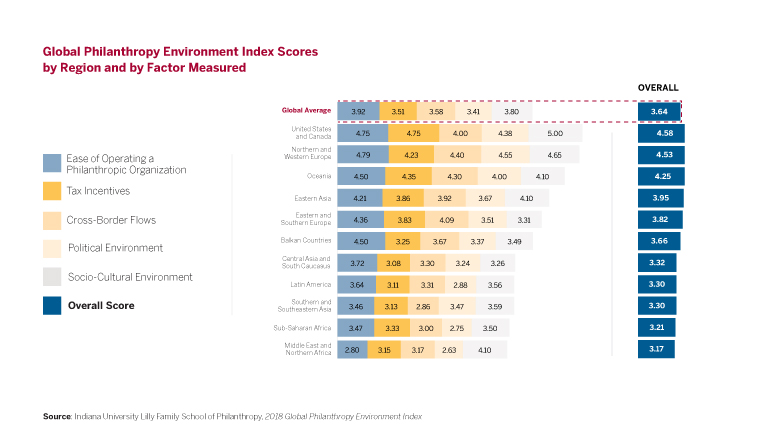The 2018 Global Philanthropy Environment Index reveals that while the regulatory conditions for philanthropy showed improvements in six of the 11 regions from 2015, the overall philanthropic environment in about 40 percent of countries and economies evaluated remains restrictive.
Importantly, the political environment presents significant challenges to philanthropic activity. The average score measuring the political environment (3.41 out of 5.0) was the lowest average score of all five factors studied. The Middle East and Northern Africa ranked lowest on political environment among the 11 regions studied, followed by Sub-Saharan Africa and Latin America.
More positively, economies with favorable philanthropic environments are linked with higher economic indicators such as per capita GDP.
Trends & Themes
High-level findings



The political environment is a critical challenge facing the philanthropic sector
The political environment—even more than the regulatory environment—can greatly undermine the work of philanthropic organizations, especially in the Middle East and Northern Africa (2.63), Sub-Saharan Africa (2.75), and Latin America (2.88), where political uncertainty is particularly acute and scores fall below the global average (3.41).

Regions with favorable environments are linked with higher per capita Gross Domestic Product (GDP)
Economies known for enabling philanthropic activities tend to see correspondingly strong levels of per capita GDP and economic development. The United States and Canada (overall index score of 4.58), Northern and Western Europe (4.53) and Oceania (4.25) had the highest regional average score, all with high levels of GDP.

Migration and natural disasters had a major influence on the philanthropic landscape between 2015 and 2018
International migration crises, such as the Syrian Refugee Crisis, and natural disasters, such as the Nepal and Mexico earthquakes, El Niño, as well as Hurricanes Matthew, Harvey, Irma, and Maria, together substantially increased the number of people needing humanitarian assistance and the number of collaborative initiatives undertaken to address these needs, with donors contributing record levels of funding.



